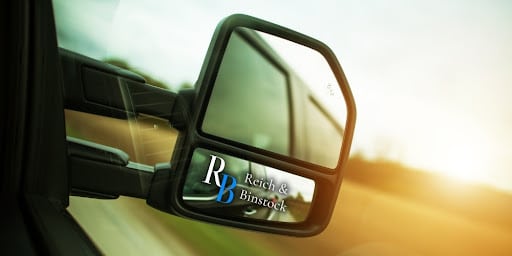Houston Blind Spot Accidents
PRACTICE AREAS

When a regular driver or a truck driver forgets to check his or her blind spot, the consequences can be catastrophic. Blind spot accidents can happen when cars drive in the blind spots of other cars or in the blind spots of truck drivers. Those involved in a blind spot truck accident often suffer major injuries, property damage to their vehicle, and more. Victims deserve full and fair compensation for their injuries.
At Reich & Binstock, our Houston car accident lawyers have extensive experience helping clients file personal injury claims against other drivers for negligence. If you were involved in a blind spot crash caused by the other driver’s negligence, our attorneys are here for you. A qualified personal injury lawyer with our firm will examine the facts of your case, gather evidence to support your claim, and even handle the insurance company for you.
While you focus on healing, we’ll focus on fighting for the compensation you deserve. To schedule a free consultation with us, please call our office at 713-622-7271 today.
Blind Spot Accident Statistics
According to the National Highway Traffic Safety Administration, approximately 800,000 blind spot crashes happen yearly. Around 300 of these are fatal. However, many more of these car accidents cause severe injuries to victims. They also have the potential to cause multi-vehicle accidents.
Many blind spot accidents occur when smaller cars drive in a truck’s blind spots. If a large, turning truck can’t see other vehicles, there’s a chance that a crash can occur. Many other blind spot accidents occur while cars are changing lanes and drivers fail to check their blind spots.
What Is a Blind Spot When Driving?
It’s important to understand both what a blind spot is and where they are located. Blind spots are the areas around a vehicle that the driver cannot see when they look in their mirrors. In most cases, they are very subtle. Some drivers are even under the impression that their vehicle has no blind spots. This false sense of security results in many avoidable accidents.
Being involved in a blind spot accident is a scary possibility, but there are steps you can take to reduce the chances of a crash.
What Is Blind Spot Driving?

Blind spot driving is a dangerous practice that many people may not even realize they’re doing. If you drive in a truck’s blind spot for a longer time than necessary, this is blind spot driving. For example, let’s say that someone is driving behind a big truck. They decide to pass the truck and, while passing, they linger in the truck driver’s blind spot.
It is extremely dangerous to linger too long in the blind spot of a commercial truck. These vehicles are very large, very heavy, and very powerful. They also have large blind spots. If they attempt lane changes while another car is in their blind spot, this could result in a crash.
Why Do Blind Spots Cause Accidents?
It’s likely clear at this point, but blind spot car and truck accidents occur due to reduced visibility. Blind spots are even more dangerous in certain areas or sections of roads. For example, certain intersections, roundabouts, roads with multiple lanes, and blind turns are all more dangerous than straight stretches of road. Changing lanes and merging are also more dangerous when it comes to blind spots.
Why Should You Never Drive in Another Car’s Blind Spot?
If the other driver cannot see you, they cannot account for where you are while turning, changing lanes, or merging. The longer you linger in someone’s blind spot, the longer your risk of a blind spot accident is elevated. When you need to pass another vehicle, speed up to pass safely and in a timely manner. You can also slow down to avoid driving right next to another vehicle.
What Causes a Blind Spot?
Certain crucial parts of a vehicle can actually block part of your view of the area around your vehicle. For example, the A-pillar, which is the support pillar for the windshield, the side view mirrors, and the rearview mirrors can all obstruct your view of the road. Other potential obstructions include cargo, headrests, and other window pillars. The blind spots block your view of certain areas of the road, which can increase your risk of accidents.
Where Are the Blind Spots in a Car?
So, where exactly are the blind spots in the average motor vehicle? Most blind spots in smaller vehicles are located to the back left and back right of the driver. These are the areas that your rear view mirror and side mirrors cannot see. Keep in mind that certain vehicles may have larger or smaller blind spots than other vehicles. Take the time to find the blind spots of your vehicle and learn to check them while you drive.
What Are Large Blind Spots on Trucks Called?

Because accidents involving large trucks are often more serious than accidents between passenger vehicles, it is even more critical to understand where their blind spots are. If you can identify them, you can avoid them. Truck drivers have to navigate with even larger blind spots than drivers of passenger cars. These large blind spots are commonly called “no zones.”
There are four major blind spots for big rigs. According to the Federal Motor Carrier Safety Administration, the large blind spot behind a tractor-trailer extends for 30 feet. In order to avoid this blind spot, it’s a good rule of thumb to stay far enough away from a truck so that you can still see their rear view mirrors.
Large trucks also have a blind spot directly in front of them. This blind spot extends approximately 20 feet in front of the truck’s cab. The other two blind spots are along each side of the truck. These areas begin at the side mirrors and extend down the sides of the truck. Notably, the right side blind spot is larger, and therefore more dangerous, than the left side.
How to Check Your Blind Spots When Driving
The best way to avoid a blind spot accident is to quickly and safely check your blind spots each time you turn, change lanes, merge, or change directions in any way. You can do this by quickly glancing over your shoulder. Do not take your eyes off the road for longer than a quick glance. Refrain from completely turning your upper body. Instead, turn your head just enough to check the peripheral that you cannot see. Lastly, adjust your mirrors to give you as much visibility as possible.
Who Is at Fault in Blind Spot Accidents?
This depends on the specific circumstances at the crash scene. In most cases, the person at fault in a blind spot accident failed to check their blind spots. Working with a personal injury attorney can make it easier for you to gather evidence to prove fault in your case. We recommend contacting a blind spot accident lawyer as soon as possible after the crash. This way, we can work with fresh evidence for your injury claim. Some of the evidence we will gather for your claim includes the following.
- Photos and videos from the accident scene
- Backup camera or side camera footage
- Damage caused to all vehicles involved
- Statements from both you and the other driver
- Police reports
- Eyewitness statements, if applicable
Damages Caused by Blind Spot Accidents

You can seek compensation for many different types of damages in a blind spot accident claim. Working with an experienced car accident lawyer can give you a better chance of getting full and fair compensation for another driver’s failure to drive safely. Below, we outline some of the most common damages in blind spot crash cases.
- Medical bills
- Property damage
- Pain and suffering
- Lost wages
- Loss of earning capacity
- Funeral and burial expenses (in wrongful death lawsuits)
Common Injuries from Blind Spot Accidents
Certain types of injuries are more common in blind spot crashes than others. Some of the most common injuries include the following.
- Back and neck injuries
- Traumatic brain injuries
- Cuts and lacerations from broken glass
- Fractures or crushed bones
- Whiplash
- Internal injuries and soft tissue damage
- Concussions
- Scarring and burn injuries
Keep in mind that many other injuries are possible in blind spot collisions. If you suffered injuries from another driver’s failure to check their blind spots, you may be entitled to compensation.
Contact a Houston Car Accident Lawyer Today
At Reich & Binstock, we fight for the rights of our clients to recover full and fair compensation for their injuries. Many accidents are avoidable, but they occur as a result of someone else’s negligence. Contact the experienced Houston personal injury attorneys at Reich & Binstock to schedule your free case review. Call our office at 713-622-7271 or fill out our online intake form to schedule with us.

